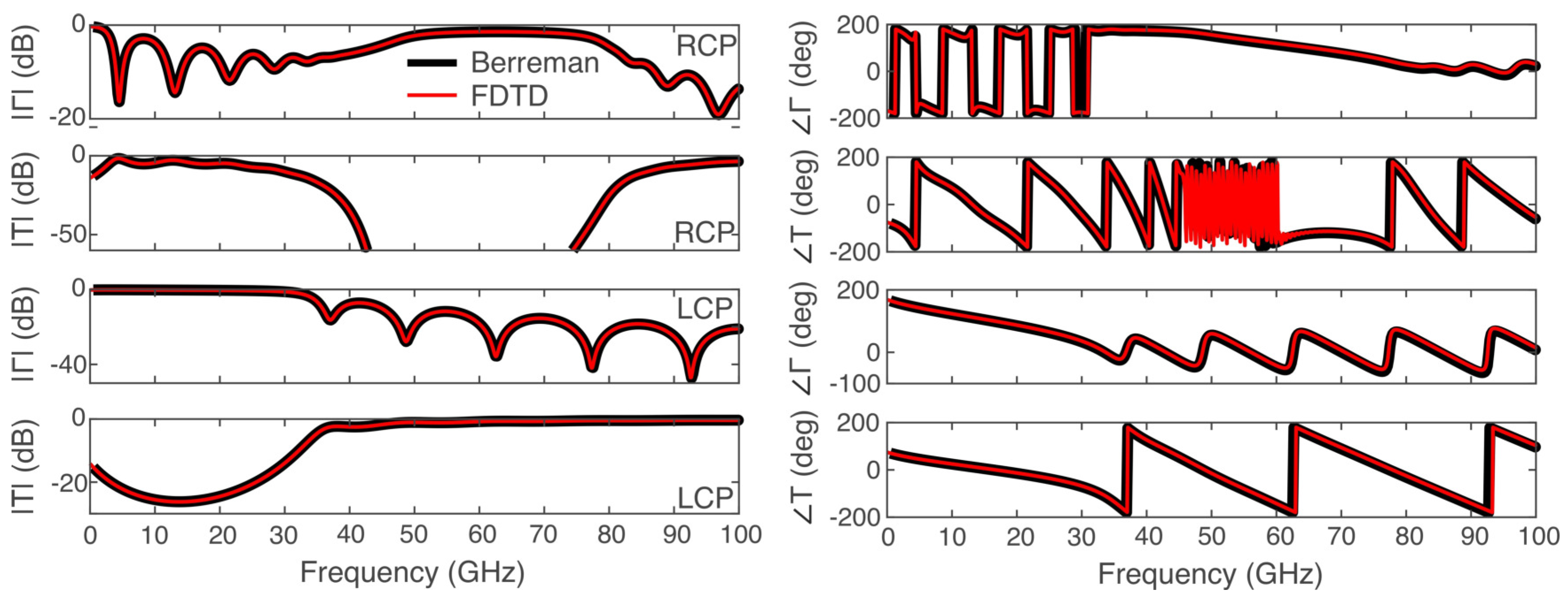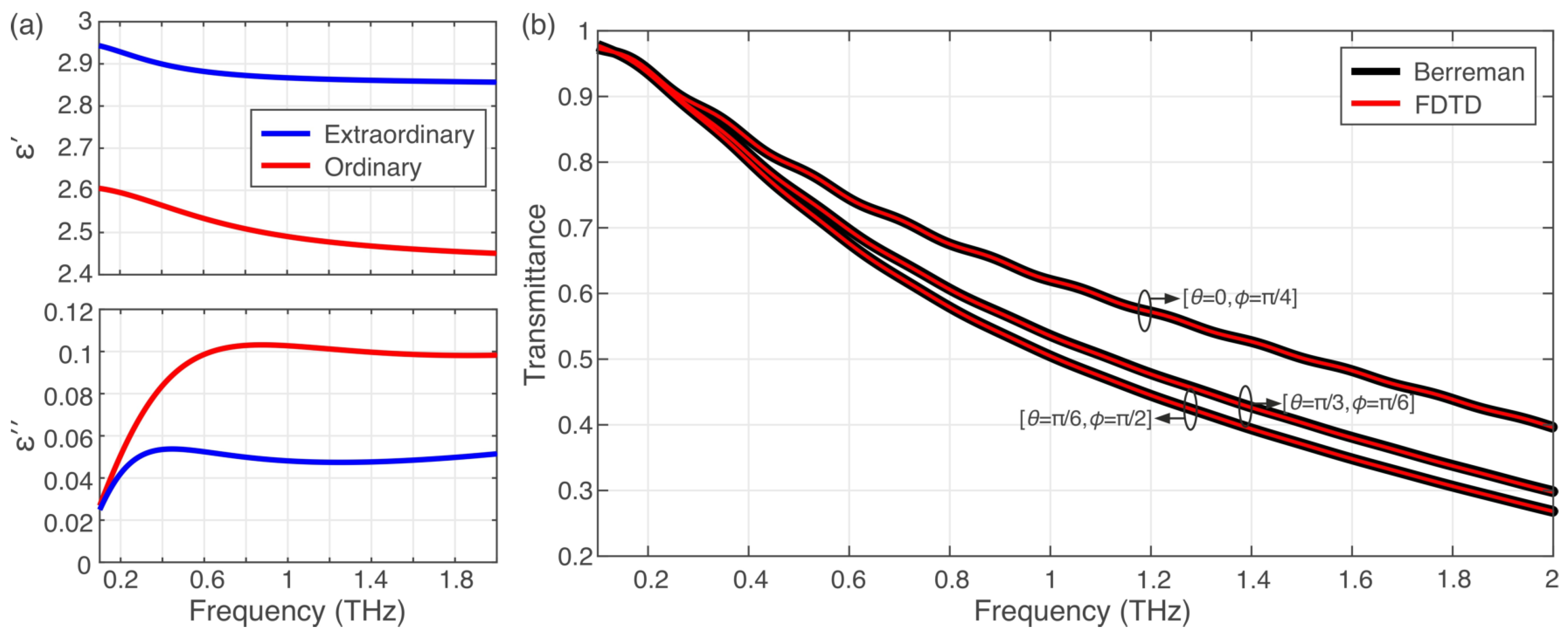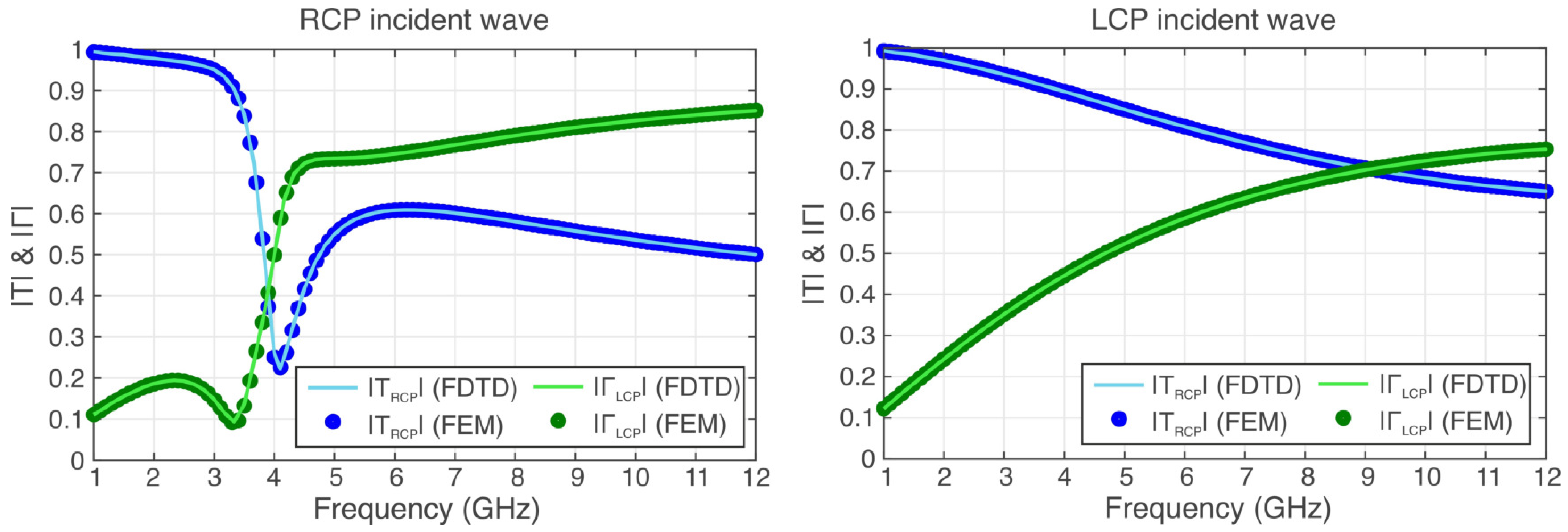Time-Domain Studies of General Dispersive Anisotropic Media by the Complex-Conjugate Pole–Residue Pairs Model
Abstract
:1. Introduction
2. Formulation
- Update , and ;
- Store the current values of , and ;
- Update , and ;
- Update , and ;
- Update , and ;
- Update , and .
3. Applications and Numerical Results
3.1. Propagation in Magnetized Plasma
3.2. Terahertz Wave Propagation through a Nematic Liquid Crystal Cell
3.3. Propagation in Ferrites
4. Conclusions
Author Contributions
Funding
Institutional Review Board Statement
Informed Consent Statement
Data Availability Statement
Conflicts of Interest
References
- Inan, U.; Marshall, R. Numerical Electromagnetics: The FDTD Method; Cambridge University Press: Cambridge, UK, 2011. [Google Scholar]
- Young, J.L.; Nelson, R.O. A summary and systematic analysis of FDTD algorithms for linearly dispersive media. IEEE Antennas Propag. Mag. 2001, 43, 61–126. [Google Scholar] [CrossRef]
- Hunsberger, F.; Luebbers, R.; Kunz, K. Finite-difference time-domain analysis of gyrotropic media. I. Magnetized plasma. IEEE Trans. Antennas Propag. 1992, 40, 1489–1495. [Google Scholar] [CrossRef]
- Huang, S.J.; Li, F. FDTD Simulation of Electromagnetic Propagation in Magnetized Plasma Using Z Transforms. Int. J. Infrared Millim. Waves 2004, 25, 815–825. [Google Scholar] [CrossRef]
- Mosallaei, H. FDTD-PLRC technique for modeling of anisotropic-dispersive media and metamaterial devices. IEEE Trans. Electromagn. Compat. 2007, 49, 649–660. [Google Scholar] [CrossRef]
- Nayyeri, V.; Soleimani, M.; Rashed Mohassel, J.; Dehmollaian, M. FDTD Modeling of Dispersive Bianisotropic Media Using Z-Transform Method. IEEE Trans. Antennas Propag. 2011, 59, 2268–2279. [Google Scholar] [CrossRef]
- Al-Jabr, A.A.; Alsunaidi, M.A.; Khee, T.; Ooi, B.S. A Simple FDTD Algorithm for Simulating EM-Wave Propagation in General Dispersive Anisotropic Material. IEEE Trans. Antennas Propag. 2013, 61, 1321–1326. [Google Scholar] [CrossRef] [Green Version]
- Zografopoulos, D.C.; Prokopidis, K.P.; Dąbrowski, R.; Beccherelli, R. Time-domain modeling of dispersive and lossy liquid-crystals for terahertz applications. Opt. Mater. Express 2014, 4, 449. [Google Scholar] [CrossRef]
- Xi, X.; Li, Z.; Liu, J.; Zhang, J. FDTD Simulation for Wave Propagation in Anisotropic Dispersive Material Based on Bilinear Transform. IEEE Trans. Antennas Propag. 2015, 63, 5134–5138. [Google Scholar] [CrossRef]
- Han, M.; Dutton, R.; Fan, S. Model dispersive media in finite-difference time-domain method with complex-conjugate pole-residue pairs. IEEE Microw. Wirel. Compon. Lett. 2006, 16, 119–121. [Google Scholar]
- Michalski, K. On the Low-Order Partial-Fraction Fitting of Dielectric Functions at Optical Wavelengths. IEEE Trans. Antennas Propag. 2013, 61, 6128–6135. [Google Scholar] [CrossRef]
- Choi, H.; Baek, J.-W.; Jung, K.-Y. Numerical Stability and Accuracy of CCPR-FDTD for Dispersive Media. IEEE Trans. Antennas Propag. 2020, 68, 7717–7720. [Google Scholar] [CrossRef]
- Prokopidis, K.P.; Zografopoulos, D.C. Time-domain numerical scheme based on low-order partial-fraction models for the broadband study of frequency-dispersive liquid crystals. J. Opt. Soc. Am. B 2016, 33, 622–629. [Google Scholar] [CrossRef]
- Prokopidis, K.P.; Zografopoulos, D.C. One-Step Leapfrog ADI-FDTD Method Using the Complex-Conjugate Pole-Residue Pairs Dispersion Model. IEEE Microw. Wirel. Compon. Lett. 2018, 28, 1068–1070. [Google Scholar] [CrossRef]
- Prokopidis, K.P.; Zografopoulos, D.C. A Unified FDTD/PML Scheme Based on Critical Points for Accurate Studies of Plasmonic Structures. J. Light. Technol. 2013, 31, 2467–2476. [Google Scholar] [CrossRef]
- Prokopidis, K.P.; Zografopoulos, D.C. Investigation of the Stability of ADE-FDTD Methods for Modified Lorentz Media. IEEE Microw. Wirel. Compon. Lett. 2014, 24, 659–661. [Google Scholar] [CrossRef]
- Rekanos, I.T.; Papadopoulos, T.G. FDTD Modeling of Wave Propagation in Cole–Cole Media With Multiple Relaxation Times. IEEE Antennas Wirel. Propag. Lett. 2010, 9, 67–69. [Google Scholar] [CrossRef]
- Rekanos, I.T. FDTD Modeling of Havriliak-Negami Media. IEEE Microw. Wireless Compon. Lett. 2012, 92, 49–51. [Google Scholar] [CrossRef]
- Gustavsen, B.; Semlyen, A. Rational approximation of frequency domain responses by vector fitting. IEEE Trans. Power Deliv. 1999, 14, 1052–1061. [Google Scholar] [CrossRef] [Green Version]
- Liu, D.; Michalski, K.A. Comparative study of bio-inspired optimization algorithms and their application to dielectric function fitting. J. Electromagn. Waves Appl. 2012, 30, 1885–1894. [Google Scholar] [CrossRef]
- Garcia-Vergara, M.; Demésy, G.; Zolla, F. Extracting an accurate model for permittivity from experimental data: Hunting complex poles from the real line. Opt. Lett. 2017, 42, 1145–1148. [Google Scholar] [CrossRef] [Green Version]
- Ishimaru, A. Electromagnetic Wave Propagation, Radiation, and Scattering: From Fundamentals to Applications; IEEE Press Series on Electromagnetic Wave Theory; John Wiley & Sons, Inc.: Hoboken, NJ, USA, 2017. [Google Scholar]
- Roden, J.A.; Gedney, S.D. Convolution PML (CPML): An efficient FDTD implementation of the CFS-PML for arbitrary media. Microw. Opt. Technol. Lett. 2000, 27, 334–339. [Google Scholar] [CrossRef]
- Stallinga, S. Berreman 4 × 4 matrix method for reflective liquid crystal displays. J. Appl. Phys. 1999, 85, 3023–3031. [Google Scholar] [CrossRef]
- Zografopoulos, D.C.; Prokopidis, K.P.; Tofani, S.; Chojnowska, O.; Dąbrowski, R.; Kriezis, E.E.; Beccherelli, R. An ADE-FDTD Formulation for the Study of Liquid-Crystal Components in the Terahertz Spectrum. Mol. Cryst. Liq. Cryst. 2015, 619, 49–60. [Google Scholar] [CrossRef]
- Prosvirnin, S.L.; Dmitriev, V.A. Electromagnetic wave diffraction by array of complex-shaped metal elements placed on ferromagnetic substrate. Eur. Phys. J. Appl. Phys. 2010, 49, 33005. [Google Scholar] [CrossRef]



| Model | Expression | Parameters of the CCPR Model: , () |
|---|---|---|
| Drude | , () | |
| Debye | 0, ) | |
| Lorentz | 0, | |
| Critical Points | 0, | |
| Sellmeier | 0, | |
| Modified Lorentz | 0, , or 0, , , |
| Tensor Element | Parameters: , () |
|---|---|
| , | |
| , | |
| , () |
| Tensor’s Element | Parameters: , () |
|---|---|
Publisher’s Note: MDPI stays neutral with regard to jurisdictional claims in published maps and institutional affiliations. |
© 2021 by the authors. Licensee MDPI, Basel, Switzerland. This article is an open access article distributed under the terms and conditions of the Creative Commons Attribution (CC BY) license (https://creativecommons.org/licenses/by/4.0/).
Share and Cite
Prokopidis, K.P.; Zografopoulos, D.C. Time-Domain Studies of General Dispersive Anisotropic Media by the Complex-Conjugate Pole–Residue Pairs Model. Appl. Sci. 2021, 11, 3844. https://doi.org/10.3390/app11093844
Prokopidis KP, Zografopoulos DC. Time-Domain Studies of General Dispersive Anisotropic Media by the Complex-Conjugate Pole–Residue Pairs Model. Applied Sciences. 2021; 11(9):3844. https://doi.org/10.3390/app11093844
Chicago/Turabian StyleProkopidis, Konstantinos P., and Dimitrios C. Zografopoulos. 2021. "Time-Domain Studies of General Dispersive Anisotropic Media by the Complex-Conjugate Pole–Residue Pairs Model" Applied Sciences 11, no. 9: 3844. https://doi.org/10.3390/app11093844
APA StyleProkopidis, K. P., & Zografopoulos, D. C. (2021). Time-Domain Studies of General Dispersive Anisotropic Media by the Complex-Conjugate Pole–Residue Pairs Model. Applied Sciences, 11(9), 3844. https://doi.org/10.3390/app11093844







